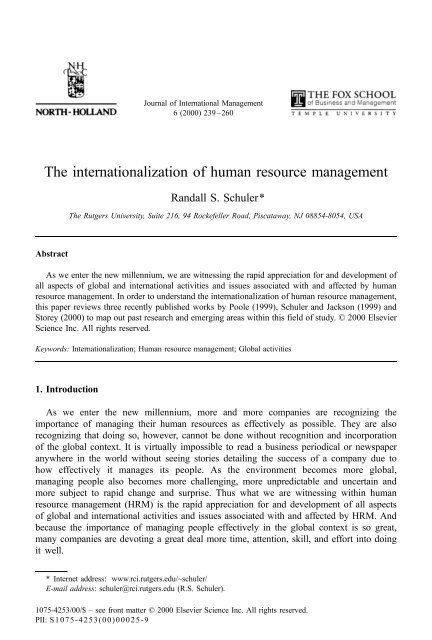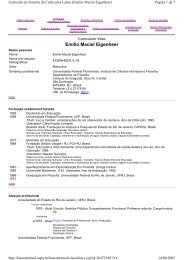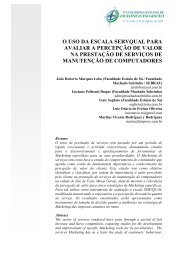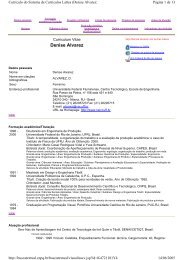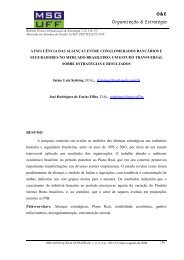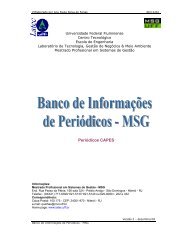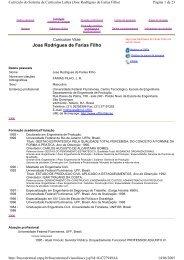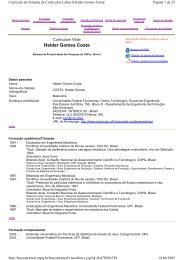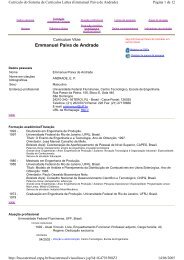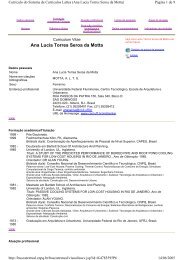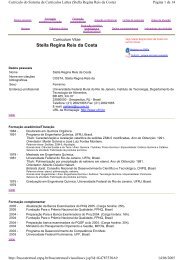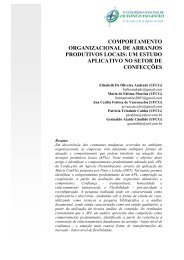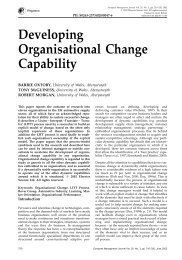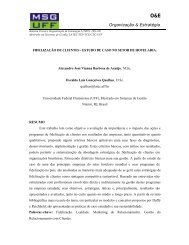The internationalization of human resource management - Latec
The internationalization of human resource management - Latec
The internationalization of human resource management - Latec
You also want an ePaper? Increase the reach of your titles
YUMPU automatically turns print PDFs into web optimized ePapers that Google loves.
Journal <strong>of</strong> International Management<br />
6 (2000) 239±260<br />
<strong>The</strong> <strong>internationalization</strong> <strong>of</strong> <strong>human</strong> <strong>resource</strong> <strong>management</strong><br />
Randall S. Schuler*<br />
<strong>The</strong> Rutgers University, Suite 216, 94 Rockefeller Road, Piscataway, NJ 08854-8054, USA<br />
Abstract<br />
As we enter the new millennium, we are witnessing the rapid appreciation for and development <strong>of</strong><br />
all aspects <strong>of</strong> global and international activities and issues associated with and affected by <strong>human</strong><br />
<strong>resource</strong> <strong>management</strong>. In order to understand the <strong>internationalization</strong> <strong>of</strong> <strong>human</strong> <strong>resource</strong> <strong>management</strong>,<br />
this paper reviews three recently published works by Poole (1999), Schuler and Jackson (1999) and<br />
Storey (2000) to map out past research and emerging areas within this field <strong>of</strong> study. D 2000 Elsevier<br />
Science Inc. All rights reserved.<br />
Keywords: Internationalization; Human <strong>resource</strong> <strong>management</strong>; Global activities<br />
1. Introduction<br />
As we enter the new millennium, more and more companies are recognizing the<br />
importance <strong>of</strong> managing their <strong>human</strong> <strong>resource</strong>s as effectively as possible. <strong>The</strong>y are also<br />
recognizing that doing so, however, cannot be done without recognition and incorporation<br />
<strong>of</strong> the global context. It is virtually impossible to read a business periodical or newspaper<br />
anywhere in the world without seeing stories detailing the success <strong>of</strong> a company due to<br />
how effectively it manages its people. As the environment becomes more global,<br />
managing people also becomes more challenging, more unpredictable and uncertain and<br />
more subject to rapid change and surprise. Thus what we are witnessing within <strong>human</strong><br />
<strong>resource</strong> <strong>management</strong> (HRM) is the rapid appreciation for and development <strong>of</strong> all aspects<br />
<strong>of</strong> global and international activities and issues associated with and affected by HRM. And<br />
because the importance <strong>of</strong> managing people effectively in the global context is so great,<br />
many companies are devoting a great deal more time, attention, skill, and effort into doing<br />
it well.<br />
* Internet address: www.rci.rutgers.edu/~schuler/<br />
E-mail address: schuler@rci.rutgers.edu (R.S. Schuler).<br />
1075-4253/00/$ ± see front matter D 2000 Elsevier Science Inc. All rights reserved.<br />
PII: S 1075-4253(00)00025-9
240<br />
R.S. Schuler / Journal <strong>of</strong> International Management 6 (2000) 239±260<br />
Together, academics and practitioners are doing more work than ever on understanding and<br />
advancing our knowledge <strong>of</strong> issues in and activities associated with managing <strong>human</strong><br />
<strong>resource</strong>s within a global context. At the same time, they are also relating the basics <strong>of</strong><br />
HRM with the context <strong>of</strong> the company.<br />
Within the global context, two <strong>of</strong> the areas <strong>of</strong> managing <strong>human</strong> <strong>resource</strong>s have evolved:<br />
comparative HRM and international HRM. Within the context <strong>of</strong> the company, the area <strong>of</strong><br />
strategic HRM (SHRM) has evolved. In essence, what we have today are four general areas<br />
<strong>of</strong> study regarding managing <strong>human</strong> <strong>resource</strong>s: (1) comparative HRM, (2) international<br />
HRM, (3) SHRM, and (4) HRM. Over the past 25 years these areas have gained increased<br />
academic and pr<strong>of</strong>essional interest. Literally thousands <strong>of</strong> articles have been written on<br />
them and have appeared in journals such as Journal <strong>of</strong> International Management,<br />
International Journal <strong>of</strong> Human Resource Management, Harvard Business Review, Organizational<br />
Dynamics, Human Resource Management Journal, Human Relations, Journal <strong>of</strong><br />
International Business, Academy <strong>of</strong> Management Review, Academy <strong>of</strong> Management<br />
Journal, European Management Journal, Annual Review <strong>of</strong> Psychology, and Journal <strong>of</strong><br />
World Business.<br />
In the interest <strong>of</strong> organizing, categorizing, prioritizing, interpreting, and critiquing these<br />
thousands <strong>of</strong> articles, three edited works appeared in 1999 and 2000. <strong>The</strong> first is a threevolume<br />
set by Michael Poole (1999) entitled Human <strong>resource</strong> <strong>management</strong>: critical<br />
perspectives on business and <strong>management</strong>. <strong>The</strong> second is by Randall S. Schuler and<br />
Susan E. Jackson (1999) entitled Strategic <strong>human</strong> <strong>resource</strong> <strong>management</strong>: a reader. <strong>The</strong><br />
third is by John Storey (2000b) entitled Human <strong>resource</strong> <strong>management</strong>: a critical text (2nd<br />
edn.). <strong>The</strong> intent <strong>of</strong> this book review is to describe the contents <strong>of</strong> these three edited<br />
works in relationship to the four areas <strong>of</strong> study and suggest where the reader can go to<br />
find the most thorough description <strong>of</strong> the areas <strong>of</strong> most interest. This is done by first<br />
briefly describing the four areas. <strong>The</strong>n the three edited works are reviewed and described<br />
in relationship to these areas.<br />
2. Human <strong>resource</strong> <strong>management</strong><br />
HRM is the basis for comparative HRM, international HRM, and SHRM and, consequently,<br />
is the largest here, and thus, is reviewed first.<br />
HRM is a vital function in organizations. It engages everyone and it take time.<br />
Managing <strong>human</strong> <strong>resource</strong>s effectively requires that the special expertise <strong>of</strong> HR pr<strong>of</strong>essionals<br />
in the HR department be used by, and in partnership with, line managers and<br />
other employees. It involves attending to the concerns <strong>of</strong> the moment while keeping a<br />
longer-term perspective in mind. It also involves continuously improving and changing<br />
activities that take time to put in place and produce results. Consequently, HRM includes<br />
(a) the people managing activities, policies, and practices that firms can use to compete<br />
effectively now, and (b) the many changing forces (e.g., new competitors, new technology,<br />
business restructuring, legal, and social concerns) that organizations need to understand<br />
and respond to in order to ensure they are positioned to compete effectively over<br />
the longer term.
R.S. Schuler / Journal <strong>of</strong> International Management 6 (2000) 239±260 241<br />
As has been argued (Poole, 1990), the theoretical base <strong>of</strong> HRM combines both multidisciplinary<br />
and interdisciplinary elements. A central aspect <strong>of</strong> HRM is the link with the<br />
organization. After all, the competitiveness <strong>of</strong> companies and nations has been increasingly<br />
recognized to stem from the caliber <strong>of</strong> their people. <strong>The</strong> significant advantages <strong>of</strong> companies<br />
having workforces that are fully developed, highly motivated, and rewarded for creativity and<br />
innovation is widely understood. But because ``the <strong>human</strong> <strong>resource</strong>'' is so central to the<br />
success <strong>of</strong> companies, strategies need to be formulated in ways in which the <strong>human</strong> assets <strong>of</strong><br />
the firm are a central feature. And this is theoretically consequential because: (1) there is not<br />
necessarily one best <strong>human</strong> <strong>resource</strong> practice or set <strong>of</strong> practices (rather, these are linked with<br />
distinctive organizational strategies, structures, and processes) and (2) <strong>human</strong> <strong>resource</strong> issues<br />
are in the domain <strong>of</strong> all managers (particularly on line and general <strong>management</strong>) and are not<br />
the preserve <strong>of</strong> the pr<strong>of</strong>essionally trained personnel specialist.<br />
HRM involves ``all <strong>management</strong> decisions and actions that affect the nature <strong>of</strong> the<br />
relationship between the organization and employeesÐits <strong>human</strong> <strong>resource</strong>s'' (Beer et al.,<br />
1984, p. 1). And it encompasses the ``development <strong>of</strong> all aspects <strong>of</strong> an organizational<br />
context'' so that they will encourage and even direct managerial behavior with regard to<br />
people (Beer et al., 1984, p. 4). HRM is organizational in its compass, it involves all<br />
managerial personnel, it regards people as the most important single asset <strong>of</strong> the organization<br />
and it seeks to enhance company performance, employee needs and societal well-being. It<br />
comprises a broad area <strong>of</strong> focus and carries with it the ideal <strong>of</strong> increasing the sum <strong>of</strong> <strong>human</strong><br />
satisfaction at a variety <strong>of</strong> levels. Moreover, other than the links with strategic <strong>management</strong><br />
from a disciplinary standpoint, it synthesizes elements from international business, organizational<br />
behavior, personnel <strong>management</strong> and industrial relations. Moreover, its diverse parent<br />
disciplines include various relevant themes from occupational psychology, labor economics<br />
and industrial sociology.<br />
2.1. <strong>The</strong> early years: personnel <strong>management</strong><br />
As with many disciplines, the study <strong>of</strong> managing people has changed rather dramatically<br />
during this century. Beginning with the works <strong>of</strong> Frederick Taylor around the turn <strong>of</strong> the<br />
century, the focus <strong>of</strong> managing people in organizations was on developing precise analytical<br />
schemes to select and reward an individual. This focus was typically for the purpose <strong>of</strong><br />
motivating, controlling, and improving the productivity <strong>of</strong> entry-level employees. During the<br />
1920s, work on these analytical schemes expanded to encompass issues <strong>of</strong> appraising and<br />
training individuals, essentially for the same purpose.<br />
While the focus during the first quarter century was on the individual employee, the second<br />
quarter was to see it shift to the group. Elton Mayo's work at the Hawthorne plant focused on<br />
improving the productivity <strong>of</strong> individuals by experimenting with groups. His efforts included<br />
changing the group composition and incentive schemes. <strong>The</strong>y also included changing<br />
environmental conditions, namely lighting and the physical arrangements. Knowledge <strong>of</strong><br />
groups and the impact <strong>of</strong> group on individuals advanced with the work <strong>of</strong> Kurt Lewin and<br />
Muzafer Sherif and Carolyn Sherif during the 1930s and into the 1940s. Yet with few notable<br />
exceptions, such as the work <strong>of</strong> Chester Barnard on CEOs, this work was focused primarily<br />
on the people doing the work.
242<br />
R.S. Schuler / Journal <strong>of</strong> International Management 6 (2000) 239±260<br />
During the 1950s and 1960s much <strong>of</strong> the work concerned with managing individuals in<br />
organizations highlighted individual needs and motivation. Advances were being made in<br />
selection and development: the Second World War work with assessment centers expanded to<br />
the private sector by the notable work conducted by Douglas Bray and his colleagues at<br />
AT&T and the development <strong>of</strong> tests for selection and placement continued. Work in<br />
performance appraisal and training progressed. Yet, again, most <strong>of</strong> the work focused,<br />
explicitly or implicitly, on improving the performance <strong>of</strong> the individuals doing the work in<br />
the organization. At this time, however, the more applied work in these areas related to<br />
managing and motivating individuals became the domain <strong>of</strong> those identifying primarily with<br />
personnel psychology and industrial and organizational psychology. <strong>The</strong> more theoretical<br />
work came under the new domain <strong>of</strong> organizational behaviorists.<br />
2.2. Enter <strong>human</strong> <strong>resource</strong> <strong>management</strong><br />
During the 1970s, another discipline evolved under the name <strong>of</strong> HRM. Encompassing the<br />
methodological tradition <strong>of</strong> the personnel and industrial and organizational psychologists and<br />
the theoretical frameworks <strong>of</strong> the organizational behaviorists, HRM took on a broader focus<br />
than earlier work. This focus included concerns for the safety and health <strong>of</strong> the worker as well<br />
as individual satisfaction and performance. Industrial relations and planning for personnel<br />
needs also came within the domain <strong>of</strong> HRM. Yet throughout the work on all the HRM topics,<br />
the primary focus <strong>of</strong> attention remained on the entry-level employee.<br />
In the late 1970s and 1980s, the discipline <strong>of</strong> organizational strategy started to make an<br />
impact upon HRM. Environmental forces, namely more intense international and domestic<br />
competition for companies, also began to make an impact. This dual blow reflected the<br />
continued theoretical and applied sides <strong>of</strong> HRM. <strong>The</strong> result <strong>of</strong> this within HRM was<br />
recognition that a substantial number <strong>of</strong> organizational characteristics not generally addressed<br />
actually had/have substantial impact upon managing <strong>human</strong> <strong>resource</strong>s. Thus, organizational<br />
characteristics such as structure, strategy, size, culture, and product and organizational life<br />
cycle began to be incorporated into the work under the HRM label.<br />
Today, forces <strong>of</strong> global competition, worldwide labor availability, business ethics, and the<br />
environment are winning the attention <strong>of</strong> HRM. Of course, this does not mean that the issues<br />
<strong>of</strong> the 1970s and 1980s can be forgotten. To the contrary, these are all carried forward,<br />
making the job <strong>of</strong> HRM challenging, rewarding, and exciting.<br />
Collectively, all these events, until the late 1970s and early 1980s, described the discipline<br />
and study <strong>of</strong> ``personnel <strong>management</strong>.'' <strong>The</strong>n the discipline and study began to change (some<br />
say that practice was actually leading theory here) and gradually assume the label <strong>of</strong><br />
``personnel and HRM'' or just ``HRM.'' Was the change in terminology a reflection <strong>of</strong> real<br />
change? Without a doubt much <strong>of</strong> the activity in SHRM and strategic international HRM<br />
(SIHRM), described later, addressed new areas <strong>of</strong> activities. <strong>The</strong> questions are then: did this<br />
change in labels really change the thrust and focus <strong>of</strong> the core personnel activities, namely<br />
staffing, appraisal and evaluation, compensation, training, safety, and industrial relations?<br />
And if so, how?<br />
Providing affirmative answers to both these questions is the insightful characterization<br />
<strong>of</strong>fered by Storey (1992). Storey <strong>of</strong>fered 27 points <strong>of</strong> difference between personnel/industrial
elations and HRM. In turn, these 27 points were grouped into three categories: beliefs and<br />
assumptions, strategic aspects, and key levers. Reducing Storey's characterization, Fig. 1<br />
<strong>of</strong>fers a scheme differentiates personnel and HRM.<br />
2.2.1. Personnel vs. <strong>human</strong> <strong>resource</strong> <strong>management</strong><br />
While exceptions can certainly be found, HRM has moved from a domestic focus to a<br />
more multinational and global focus. <strong>The</strong>re is more concern now for the environment,<br />
including ecological issues, and for healthcare and illiteracy. Organizationally, HRM has gone<br />
from being concerned only with the operational issues <strong>of</strong> personnel to include the more<br />
strategic, business level concerns <strong>of</strong> the organization itself. Human <strong>resource</strong> departments<br />
might also be concerned about the operations <strong>of</strong> key suppliers and customers. Managerially,<br />
<strong>human</strong> <strong>resource</strong> pr<strong>of</strong>essionals are working more closely with the line managers, to some<br />
extent a customer <strong>of</strong> the <strong>human</strong> <strong>resource</strong> department. As the <strong>human</strong> <strong>resource</strong> pr<strong>of</strong>ession has<br />
become more involved in the global, external, and strategic issues <strong>of</strong> the organization, so has<br />
its critical goals changed. Whereas the goals in ``personnel <strong>management</strong>'' were attracting,<br />
retaining, and motivating workers, the goals <strong>of</strong> ``HRM'' are concerned with the bottom line:<br />
competitiveness, pr<strong>of</strong>itability, survival, competitive advantage, and workforce flexibility.<br />
While the goals <strong>of</strong> attracting, retaining, and motivating are still important, they are critical<br />
primarily as a means by which to reach, and improve the bottom-line goals.<br />
This is a move away from a functional orientation where the concern was with developing<br />
<strong>human</strong> <strong>resource</strong> products and services rather than understanding the <strong>human</strong> <strong>resource</strong><br />
implications <strong>of</strong> the business and the managers. Concurrently, <strong>human</strong> <strong>resource</strong> pr<strong>of</strong>essionals<br />
have become more generalists. This trend is articulated at the individual level (each <strong>human</strong><br />
<strong>resource</strong> pr<strong>of</strong>essional becoming multi-skilled) and at the departmental level (teams <strong>of</strong><br />
different specialists work together to serve the customer). In relation to the employees, the<br />
<strong>human</strong> <strong>resource</strong> department and the pr<strong>of</strong>essionals have moved from a philosophical orientation<br />
<strong>of</strong> conflict and differentiation to one <strong>of</strong> harmony and egalitarianism. In the area <strong>of</strong> <strong>human</strong><br />
<strong>resource</strong> practices, whereas personnel <strong>management</strong> is associated with practices that are<br />
narrowly targeted and individually focused, HRM is associated with practices that are more<br />
broadly conceived and team-focused.<br />
This rather brief history is meant to provide the reader with a supplemental perspective to<br />
that developed by Storey (1992) in describing the general differences between personnel<br />
<strong>management</strong> and HRM. While the characterizations in Fig. 1 provide relatively clear<br />
differences, in practice it is not surprising to find something less than these pure types.<br />
Accordingly, these characterizations are presented in Fig. 1 not as either/or choices but rather<br />
end points on several continua. In fact, this has also reflected the evolution <strong>of</strong> the discipline<br />
with academia. Articles and books evolved from being titled ``personnel/industrial relations<br />
<strong>management</strong>'' to ``personnel and HRM'' to ``HRM.'' It is suggested here that this evolution<br />
represented movement along the continua presented in Fig. 1.<br />
2.3. Debates today<br />
R.S. Schuler / Journal <strong>of</strong> International Management 6 (2000) 239±260 243<br />
As this evolution and transformation <strong>of</strong> the field <strong>of</strong> studying and managing <strong>human</strong> <strong>resource</strong>s<br />
have taken place, debates in the field have also evolved (Poole, 1999). <strong>The</strong> worthy debates are
244<br />
R.S. Schuler / Journal <strong>of</strong> International Management 6 (2000) 239±260<br />
Fig. 1. Comparisons between personnel and HRM.<br />
many, but the ones <strong>of</strong>fered here reflect the six topics given in Fig. 1. While there may be<br />
differences in the debates depending on which side <strong>of</strong> the Atlantic one stands, these differences<br />
are perhaps more <strong>of</strong> degree than kind (Sparrow and Hiltrop, 1994; Brewster, 2000).<br />
In terms <strong>of</strong> the environmental topic, debate revolves around the extent to which the <strong>human</strong><br />
<strong>resource</strong> community should be involved in greater social problems outside the organization.<br />
Perhaps the best contribution HRM can make to the community is to make its own<br />
organization as effective and efficient as possible. Others say, <strong>of</strong> course, that it is impossible<br />
not to be concerned about the impact <strong>of</strong> the organization upon the environment and its<br />
dependence for supplies, such as skilled individuals.<br />
Some would also debate the appropriateness and the ability <strong>of</strong> HRM to become more<br />
organizationally linked. <strong>The</strong>re are many problems such as healthcare and literacy that are<br />
critical to the organization and rightly fall to the <strong>human</strong> <strong>resource</strong> department. Responsibility<br />
for these areas, some would suggest, is right and appropriate for HRM. Expanding beyond<br />
this operational domain <strong>of</strong> personnel is thus unnecessary. Furthermore, as <strong>human</strong> <strong>resource</strong><br />
practitioners are not trained to be knowledgeable in the business, they lack the ability to link<br />
their activities to the organization.<br />
Continuing with the same line <strong>of</strong> reasoning then, the <strong>human</strong> <strong>resource</strong> manager probably<br />
best serves the line manager by acting as the behind-the-scenes supplier <strong>of</strong> materials and lines<br />
rather than as in equal partnership on center stage.
R.S. Schuler / Journal <strong>of</strong> International Management 6 (2000) 239±260 245<br />
If the HR pr<strong>of</strong>ession is really one requiring training and the possession <strong>of</strong> a technical body<br />
<strong>of</strong> knowledge, is the HR pr<strong>of</strong>essional likely to be more effective if focused on a limited<br />
number <strong>of</strong> topics or practices? Can the compensation specialist really be expected to develop<br />
valid selection tests? Within academia a similar debate is heard: should business schools be<br />
left to teach only the general, more strategically focused HRM, thereby leaving the<br />
psychology departments or schools <strong>of</strong> HRM and industrial relations to teach the traditional<br />
personnel <strong>management</strong> specialities?<br />
Is the harmony model possible between workers and managers? Are these two groups<br />
really <strong>of</strong> the same cloth? Will there always be conflict between the owners and their<br />
representatives and the workers? Is the <strong>human</strong> <strong>resource</strong> pr<strong>of</strong>essional, perhaps by playing the<br />
role <strong>of</strong> partner, subverting the true interests <strong>of</strong> the workers? Of course, the defending position<br />
here says that the partnership role for HRM implies not carrying out what is in the interests <strong>of</strong><br />
the managers, but rather what is in the best interests <strong>of</strong> the business. Is it reasonable to assume<br />
that the manager acts in the interests <strong>of</strong> the business better than others, including the <strong>human</strong><br />
<strong>resource</strong> manager? Here it can be argued that the expression <strong>of</strong> partnership means the <strong>human</strong><br />
<strong>resource</strong> manager working with managers and the workers and their representatives in the<br />
best interests <strong>of</strong> the business and the best interests <strong>of</strong> the community.<br />
In countries described as being individualistic by H<strong>of</strong>stede (1980), is it appropriate, indeed<br />
ethical, to impose team-focused <strong>human</strong> <strong>resource</strong> practices on the workers? Regardless <strong>of</strong><br />
whether workers are working effectively in teams to improve quality today, will they be able<br />
to continue this type <strong>of</strong> activity? In the short run workers can adapt, but is this in their best<br />
interests in the long term? Similarly, is it fair for superior workers to accept an average wage<br />
for the group's productivity? Or, is it fair and reasonable to ask workers to evaluate each other<br />
(indeed, is this consistent with the model <strong>of</strong> harmony?) or to make decisions about employing<br />
and dismissing? In this process is the organization asking the workers to represent themselves<br />
rather than asking a formal union organization to represent them? <strong>The</strong> debate can continue by<br />
focusing on the real role <strong>of</strong> teams and harmony. Is it really to improve efficiency and the lot <strong>of</strong><br />
the workers, or is it to remove the force <strong>of</strong> the union from the workplace? As <strong>human</strong> <strong>resource</strong><br />
practices move from being more narrowly developed to more broadly developed, are<br />
organizations making themselves more attractive and unions less attractive to the workers?<br />
Are workers more empowered and involved less likely to seek power through third-party<br />
representation? And even if workers do respond favorably and this serves the organization<br />
well in doing battle with global competition, who guarantees that these conditions will last?<br />
In summary, the discipline <strong>of</strong> managing <strong>human</strong> in organizations has transformed itself<br />
tremendously throughout the 20th century. Today what organizations and the <strong>human</strong><br />
<strong>resource</strong>/personnel pr<strong>of</strong>essional have is a range <strong>of</strong> alternatives for managing <strong>human</strong><br />
<strong>resource</strong>s. Similarly, academics have an equally vast set <strong>of</strong> topics to address. <strong>The</strong>se topics<br />
and how they are being addressed are covered in a number <strong>of</strong> the articles contained in the<br />
books reviewed here.<br />
2.4. Multiple stakeholder perspective<br />
Today organizations are faced with increased social pressure to behave in a socially<br />
responsible manner. In part this pressure comes from society at large, in its role as one <strong>of</strong>
246<br />
R.S. Schuler / Journal <strong>of</strong> International Management 6 (2000) 239±260<br />
several stakeholders <strong>of</strong> the organization. But society is just one <strong>of</strong> several stakeholders for<br />
organizations, and consequently, for HRM (Jackson and Schuler, 2000).<br />
2.4.1. Elements <strong>of</strong> the stakeholder model<br />
<strong>The</strong> organization as a whole can be viewed as a stakeholder <strong>of</strong> HRM. <strong>The</strong><br />
organization's objectives <strong>of</strong> improving productivity, improving pr<strong>of</strong>itability, and surviving<br />
in general all impact HRM. <strong>The</strong> employees are one <strong>of</strong> the most important stakeholders<br />
in the organization, even in those organizations not owned by the employees. <strong>The</strong><br />
emphasis placed on the role <strong>of</strong> the employees within the organization has increased,<br />
particularly in light <strong>of</strong> the adoption <strong>of</strong> strategies <strong>of</strong> total quality <strong>management</strong> and<br />
customer-focused <strong>management</strong>.<br />
<strong>The</strong> emphasis on customer service and strategic partnering with customers has become<br />
more prominent, in part as a result <strong>of</strong> the just-in-time manufacturing initiatives and total<br />
quality <strong>management</strong>.<br />
Investors are viewed as one <strong>of</strong> the most important stakeholders because without their<br />
capital, the business could not continue. <strong>The</strong> time orientation <strong>of</strong> the investors is a driving<br />
force for the corporation as well. To the extent that investors are focused solely on the shortterm<br />
pr<strong>of</strong>its <strong>of</strong> the corporation, the good <strong>of</strong> the corporation can be jeopardized.<br />
<strong>The</strong> role <strong>of</strong> strategic business partner is a relatively new one for the HR department.<br />
However, as the focus <strong>of</strong> the department has shifted to include both long- and short-term<br />
goals, and to act as an internal supplier <strong>of</strong> skills to the organization, the role <strong>of</strong> strategic<br />
business partner has emerged.<br />
Society, in general, is viewed as being a stakeholder as well. Societal needs are made<br />
manifest in several different arenas: the legal framework under which the organization<br />
operates, the social mores <strong>of</strong> the areas in which the organization operates, and the constraints<br />
imposed by the natural environment.<br />
2.5. <strong>The</strong>oretical frameworks for <strong>human</strong> <strong>resource</strong> <strong>management</strong><br />
<strong>The</strong> area <strong>of</strong> HRM today is being supported, developed, and understood using a variety <strong>of</strong><br />
theoretical frameworks (Jackson and Schuler, 1995).<br />
2.5.1. Resource dependence theory<br />
Resource dependence theory stems from the relationship between an organization<br />
and its constituencies. This theory emphasizes the need for <strong>resource</strong>s as being primary<br />
in the determination <strong>of</strong> policies and procedures. Organizations are viewed as being able<br />
to succeed by gaining and retaining control over scarce valuable <strong>resource</strong>s, such as<br />
<strong>human</strong> <strong>resource</strong>s.<br />
2.5.2. Competitive advantage theory<br />
Competitive advantage theory dictates that a competitive advantage exists if the <strong>resource</strong> is<br />
rare, inimitable, non-substitutable and valuable. Competitive advantage can be sustained<br />
through continued training, support <strong>of</strong> organizational culture, selection processes and other<br />
traditional <strong>human</strong> <strong>resource</strong> practices.
R.S. Schuler / Journal <strong>of</strong> International Management 6 (2000) 239±260 247<br />
2.5.3. Institutionalist theory<br />
Institutionalism suggests that organizations operate in a manner consistent with the<br />
rationalized myths that will garner them legitimacy in their external environment. This<br />
external environment is made up <strong>of</strong> a broad variety <strong>of</strong> stakeholders. This adherence to<br />
rationalized myths in an attempt to retain legitimacy results in both survival and constraints<br />
on organizational actions.<br />
2.5.4. Agency theory<br />
Agency theory is perhaps one <strong>of</strong> the most related theories to <strong>human</strong> <strong>resource</strong> practices. From<br />
the legal perspective, an agency relationship exists between an employer and an employee.<br />
Agency theory posits that this relationship may be subject to difficulties to the extent that the<br />
employer and the employee (in legalese, the principal and the agent, respectively) have<br />
differing goals, and when monitoring the employee's actions is difficult for the employer.<br />
2.5.5. General systems theory<br />
General systems theory views systems as made up <strong>of</strong> complex, independent parts. Inputs to<br />
this open system come from the environment, are transformed during processing through the<br />
system, and are returned to the environment. Using an open systems model, HRM is studied<br />
as a subsystem within the larger system <strong>of</strong> the organization.<br />
2.5.6. Human capital theory<br />
Human capital theory appears largely in the economics literature in reference to people's<br />
productive capacities. <strong>The</strong> crux <strong>of</strong> this theory is that people are <strong>of</strong> value to the organization<br />
because they make it productive. In essence, the organization has invested in people just as if<br />
they had invested in machinery, viewing them as an additional type <strong>of</strong> capital.<br />
2.5.7. Life cycle theory<br />
Life cycle theory notes that there are several stages <strong>of</strong> the life <strong>of</strong> an organization. <strong>The</strong>se<br />
stages have been described as start-up, growth, maturity, decline, and revival. As an<br />
organization moves through these stages, researchers have suggested that HRM practices<br />
that fit with the life cycle stage <strong>of</strong> the organization will result in organizational effectiveness.<br />
2.5.8. Role behavior theory<br />
Role behavior focuses on the interdependent role behaviors as building blocks for the<br />
organizational system. According to Katz and Kahn (1978), role behaviors are defined as<br />
``the recurring actions <strong>of</strong> an individual, appropriately interrelated with the repetitive activities<br />
<strong>of</strong> others so as to yield a predictable outcome.'' <strong>The</strong> primary means by which the organization<br />
sends role information through the organization, supports desired behaviors, and evaluates<br />
role performances is HRM.<br />
2.5.9. Organizational change theory<br />
Organizational change theory focuses on the difference in form, quality or state over<br />
time in an organizational entity. Organizational change theory adds two pieces to the<br />
understanding <strong>of</strong> HRM. First, in <strong>management</strong> <strong>of</strong> organizational change, organizations
248<br />
R.S. Schuler / Journal <strong>of</strong> International Management 6 (2000) 239±260<br />
need to ensure congruence between the stated goals and stated changes and the<br />
enacted changes.<br />
2.5.10. Transactions cost theory<br />
Transactions cost theory takes an economic viewpoint <strong>of</strong> the creation <strong>of</strong> governance<br />
structures that establish, monitor, evaluate, and enforce exchanges previously agreed upon.<br />
Central to this theory are two assumptions: bounded rationality and opportunism. Opportunism<br />
assumes that if any potential for advantage exists, it will be taken. On the part <strong>of</strong><br />
employees, the potential for opportunism exists when the employee is specially trained or<br />
possesses specialized knowledge or skills that have a market value to other organizations.<br />
Bounded rationality dictates that there are a limited number <strong>of</strong> options that can be assessed by<br />
any given organization prior to making a decision. Human <strong>resource</strong> activities seek to take<br />
advantage <strong>of</strong> bounded rationality while attempting to prevent the exercise <strong>of</strong> opportunism<br />
through the execution <strong>of</strong> contracts, the creation <strong>of</strong> monitoring and compliance assurance<br />
systems and through the revision <strong>of</strong> the contracts when necessary.<br />
2.5.11. Strategic contingency theory<br />
Strategic contingency theory recognizes that there are several strategic typologies. <strong>The</strong><br />
choice made by an organization <strong>of</strong> which strategy to pursue requires systematic <strong>management</strong><br />
<strong>of</strong> <strong>human</strong> <strong>resource</strong>s in order to ensure appropriate and successful implementation. Strategic<br />
contingency theory posits that the choice between various typologies is dependent upon the<br />
environment within which the organization operates.<br />
2.5.12. Organizational learning theory<br />
According to organizational learning theory perspective, prior learning facilitates the<br />
learning and application on new, related knowledge. This idea can be extended to include the<br />
case in which the knowledge in question is itself a set <strong>of</strong> learning skills constituting a firm's<br />
absorptive capacity.<br />
2.5.13. Information processing perspective<br />
This perspective is based on the premise that organizations are created to facilitate the flow<br />
<strong>of</strong> information for effective individual and organizational decision-making. <strong>The</strong> focus is on<br />
the capacity and facilitation characteristics <strong>of</strong> organizational structure and practices such as<br />
<strong>human</strong> <strong>resource</strong> ones that support, encourage, and reward transfer <strong>of</strong> information within the<br />
organization, across its boundaries to IJV partners and the IJV itself, and that enables the<br />
organization to acquire knowledge to transform the data and information. All these theories<br />
are being used today to help develop the area <strong>of</strong> HRM. Many are also being used to help<br />
develop and understand international HRM.<br />
3. Comparative <strong>human</strong> <strong>resource</strong> <strong>management</strong><br />
As international competition has intensified, practitioners and scholars have turned their<br />
attention to the question <strong>of</strong> what factors affect the ability <strong>of</strong> nations and their businesses to
R.S. Schuler / Journal <strong>of</strong> International Management 6 (2000) 239±260 249<br />
adapt more effectively to the economic and social change required to survive in this<br />
competitive environment. For example, a growing literature has emerged about the<br />
contribution <strong>of</strong> internal and external labor market flexibility to successful economic<br />
performance. And countries like Germany have moved to deregulate the labor market to<br />
enhance flexibility and employment. But the underlying theory that describes and explains<br />
how variations in comparative <strong>human</strong> <strong>resource</strong> <strong>management</strong> systems (HRMSs) operate to<br />
impact firm and, therefore, societal performance has been slow to develop, in large measure<br />
because <strong>of</strong> the methodological difficulties involved in carrying out the large-scale comparative<br />
research important to theory development (Begin, 1997). Much <strong>of</strong> the scholarship related<br />
to understanding international HRM issues deals with the problems <strong>of</strong> multinational<br />
companies operating across countries (Dowling et al., 1999). <strong>The</strong> alternate perspective <strong>of</strong><br />
comparing the complete HRMSs <strong>of</strong> different countries has been explored more sparingly;<br />
indeed, much <strong>of</strong> the work that has been published primarily has focused on the collective<br />
bargaining functions <strong>of</strong> HRMs. In recent years, though, good comparative research on<br />
national HRMSs has begun to emerge (Brewster and Cranfield colleagues throughout, 1990).<br />
However, almost none <strong>of</strong> the work comprehensively and systematically has examined HR<br />
practices in relation to each other and to business strategy to determine how these practices<br />
contribute to competitive advantage. This is the essence <strong>of</strong> comparative HRM, thus HRM in<br />
this international context requires focus on the functions, policies, and practices <strong>of</strong> HRM in<br />
different countries.<br />
Different countries have different national cultures that have different HRM implications.<br />
One <strong>of</strong> the challenges that faces organizations as they globalize their operations is the<br />
adaptation <strong>of</strong> their HR practices to the new set <strong>of</strong> cultures in which the organization is<br />
operating and the creation <strong>of</strong> a manner <strong>of</strong> operation that is both comfortable to the<br />
organization, and appropriate for those cultures. This market challenge is true for firms all<br />
over the globe. As organizations become more global and begin to do business in greater<br />
numbers <strong>of</strong> areas, the number and variety <strong>of</strong> cultures represented in their workforce also<br />
changes. As this number increases and as organizations attempt to treat each different culture<br />
with respect, practical issues can arise that may make doing business increasingly more<br />
difficult. For example, which religious and secular holidays need to be honored based on the<br />
cultures represented in the workforce? Similarly, questions may arise regarding what the<br />
<strong>of</strong>ficial language <strong>of</strong> the workplace will be and whether the speaking <strong>of</strong> other languages to coworkers<br />
will be accepted. Of course, many other aspects <strong>of</strong> individual motives vary also such<br />
as legal, political labor market, and economic conditions and these are critical for<br />
comparative HRM.<br />
4. Strategic <strong>human</strong> <strong>resource</strong> <strong>management</strong><br />
SHRM is largely about integration and adaptation (Schuler and Jackson, 1999). Its concern<br />
is to ensure that: (1) HRM is fully integrated with the organization as articulated through its<br />
strategy and the strategic needs <strong>of</strong> the firm; (2) <strong>human</strong> <strong>resource</strong> practices are consistent both<br />
across policy areas and across hierarchies; and (3) <strong>human</strong> <strong>resource</strong> practices are adjusted,<br />
accepted, and used by line managers and employees as part <strong>of</strong> their everyday work.
250<br />
R.S. Schuler / Journal <strong>of</strong> International Management 6 (2000) 239±260<br />
Together, these viewpoints suggest that SHRM has many different components,<br />
including activities, policies and practices. <strong>The</strong> various statements also imply what<br />
SHRM does: it links, it integrates, and it connects across levels in organizations.<br />
Fig. 2. <strong>The</strong> strategic <strong>management</strong> process and its implications for <strong>human</strong> <strong>resource</strong> <strong>management</strong> (#S.E. Jackson<br />
and R.S. Schuler, 2000).
R.S. Schuler / Journal <strong>of</strong> International Management 6 (2000) 239±260 251<br />
Implicitly or explicitly, its purpose is to more effectively utilize <strong>human</strong> <strong>resource</strong>s vis-avis<br />
the strategic needs <strong>of</strong> the organization. <strong>The</strong> key components <strong>of</strong> SHRM are illustrated<br />
in Fig. 2.<br />
Typically, organizations define (or redefine) their strategic business needs during times <strong>of</strong><br />
turbulence. As such, these needs reflect <strong>management</strong>'s overall plan for survival, growth,<br />
adaptability, and pr<strong>of</strong>itability. Internal characteristics (such as culture and the nature <strong>of</strong> the<br />
business) as well as external characteristics (such as the state <strong>of</strong> the economy and critical<br />
success factors in the industry) may well influence the definition <strong>of</strong> needs. <strong>The</strong> biggest factor<br />
affecting SHRM, however, is not a particular characteristic so much as it is experience with<br />
this mode <strong>of</strong> planning. Human <strong>resource</strong> managers who have never before been asked to meld<br />
<strong>human</strong> <strong>resource</strong> activities with strategic needs will find that the process takes time,<br />
persistence, and a detailed understanding <strong>of</strong> the needs that have been defined. In fact,<br />
linkages between <strong>human</strong> <strong>resource</strong> activities and business needs tend to be the exception even<br />
during non-turbulent times. When such linkages do occur, they are usually driven by the<br />
organization's efforts to formulate and implement a particular strategy (Thompson and<br />
Strickland, 1998).<br />
To trigger specific actions, the business needs are generally translated into more<br />
actionable statements, which might be called ``strategic business objectives.'' For other<br />
organizations, these might be called ``business vision statements.'' By calling them<br />
strategic business objectives, firms believe that the statement conveys a more specific<br />
action element, starting with an influence on a variety <strong>of</strong> <strong>human</strong> <strong>resource</strong> activities<br />
(Schuler et al., 2000).<br />
5. International <strong>human</strong> <strong>resource</strong> <strong>management</strong><br />
<strong>The</strong> world has become more competitive, dynamic, uncertain, and volatile than ever<br />
before (Kanter, 1991; Dowling et al., 1999). To be successful, many firms have to<br />
compete on the global playing field because the costs associated with the development<br />
and marketing <strong>of</strong> new products are too great to be amortized only over one market,<br />
even a large one such as the USA or Europe (Bartlett and Ghoshal, 1991). Yet there<br />
are some products and services that demand accommodation to location customs,<br />
tastes, habits, and regulations. Thus, for many multinational enterprises (MNEs) the<br />
likelihood <strong>of</strong> operating in diverse environments has never been greater. While these<br />
scenarios suggest paths that MNEs have indeed taken to being internationally<br />
competitive, they are being superseded by the need both to manage globally, as if<br />
the world were one vast market, and simultaneously to manage locally, as if the world<br />
were a vast number <strong>of</strong> separate and loosely connected markets (Bartlett and Ghoshal,<br />
1991). <strong>The</strong> trend is creating a great deal <strong>of</strong> challenge and opportunity in understanding<br />
and conceptualizing exactly how MNEs can compete effectively. Knowledge <strong>of</strong><br />
conditions in a variety <strong>of</strong> countries and knowledge <strong>of</strong> how to manage both within<br />
and across them is the essence <strong>of</strong> international HRM. <strong>The</strong> complexities <strong>of</strong> operating in<br />
different countries and employing different national categories <strong>of</strong> workers is a key<br />
variable that differentiates domestic and international HRM, rather than any major
252<br />
R.S. Schuler / Journal <strong>of</strong> International Management 6 (2000) 239±260<br />
differences between the HRM activities performed (Dowling et al., 1999). Further<br />
differentiating these two areas is the linking <strong>of</strong> HRM with strategic or organizational<br />
level issues <strong>of</strong> MNEs.<br />
5.1. Strategic international <strong>human</strong> <strong>resource</strong> <strong>management</strong><br />
SIHRM is defined as ``<strong>human</strong> <strong>resource</strong> <strong>management</strong> issues, functions, and policies and<br />
practices that result from the strategic activities <strong>of</strong> MNEs and that impact the international<br />
concerns and goals <strong>of</strong> those enterprises'' (Schuler et al., 1993).<br />
While this definition is certainly consistent with the definition <strong>of</strong> HRM presented within a<br />
single country or domestic context (for examples, see Boam and Sparrow, 1992; Jackson and<br />
Schuler, 2000), it facilitates the inclusion <strong>of</strong> a significant number <strong>of</strong> factors discussed in the<br />
international literature, both in the areas <strong>of</strong> international <strong>management</strong> and business, and<br />
international HRM (Phatak, 1992; Dowling et al., 1999). <strong>The</strong>se factors and their relationships<br />
are illustrated in Fig. 3.<br />
With the concern for being global and the concern about the transfer <strong>of</strong> learning and being<br />
multidomestic and, therefore, simultaneously being sensitive to local conditions several<br />
strategic concerns relevant to international HRM arise. For example, can and how do MNEs<br />
link their globally dispersed units through <strong>human</strong> <strong>resource</strong> policies and practices? Can and<br />
how do MNEs facilitate a multidomestic response that is simultaneously consistent with the<br />
need for global coordination and the transfer <strong>of</strong> learning and innovation across units through<br />
<strong>human</strong> <strong>resource</strong> policies and practices?<br />
Fig. 3. Factors in SIHRM.
R.S. Schuler / Journal <strong>of</strong> International Management 6 (2000) 239±260 253<br />
6. Poole's three volumes: Human <strong>resource</strong> <strong>management</strong>: critical perspectives on business<br />
and <strong>management</strong><br />
Each <strong>of</strong> these four areas <strong>of</strong> managing <strong>human</strong> <strong>resource</strong>s has been developed at a rapid pace<br />
over the past two and a half decades. A great deal <strong>of</strong> writing has been done in each area by<br />
scholars worldwide. To help navigate through the essence <strong>of</strong> what has been written, and to<br />
help define/identify the key topics, issues, debates, theories, and directions, Michael Poole<br />
has edited a three-volume set <strong>of</strong> articles. According to Poole<br />
<strong>The</strong> aim <strong>of</strong> this three-volume collection is to set out many <strong>of</strong> the main landmarks<br />
contribution to the theoretical, conceptual and critical advance <strong>of</strong> the subject. <strong>The</strong><br />
four main themes selected encompass: (1) origins, developments and critical<br />
analyses (Vol. 1), (2) comparative and international perspectives on <strong>human</strong><br />
<strong>resource</strong> <strong>management</strong> focusing on theoretical and methodological concerns (Vol.<br />
II, Part 1), (3) strategic <strong>human</strong> <strong>resource</strong> <strong>management</strong>, strategy and competitiveness<br />
(Vol. II, Part 2), and (4) emergent issues for the new millennium (globalization and<br />
the multinational enterprise, international assignments and expatriation, managing<br />
diversity, competencies and knowledge, innovation and creativity, and morality<br />
and ethics) (Vol. III). <strong>The</strong> main contributions to all <strong>of</strong> these areas will be developed<br />
in this introductory section. But first it is necessary to say something (if only<br />
briefly) about <strong>human</strong> <strong>resource</strong> <strong>management</strong> itself.<br />
Thus in his three volumes, Poole collects for the reader many <strong>of</strong> the essential writings in<br />
each area.<br />
6.1. Vol. I: Organizing developments and critical analysis<br />
As for each volume, Poole presents and extensive introduction <strong>of</strong> the articles selected.<br />
<strong>The</strong> introduction contains the rationale for the selection <strong>of</strong> each article along with a lengthy<br />
description <strong>of</strong> its contents. In so doing, he critiques the significance, relevance, and<br />
particular contributions to the area. <strong>The</strong>se introductions are invaluable contributions in and<br />
<strong>of</strong> themselves.<br />
<strong>The</strong> area addressed by the 13 articles in Vol. I is ``HRM.'' Included here are classic<br />
contributions that defined, shaped, guided, and even questioned the newly emerging area <strong>of</strong><br />
HRM. Contributions included work from US-based authors such as Miles (1965, ``Human<br />
relations or <strong>human</strong> <strong>resource</strong>s?''), Beer et al. (1984, ``A conceptual overview <strong>of</strong> HRM''), and<br />
Kochan and Cappelli (1984, ``Transformation <strong>of</strong> the industrial relations and personnel<br />
function''). Contributions also include work from UK-based authors such as Storey (1989,<br />
``Introduction: from personnel <strong>management</strong> to <strong>human</strong> <strong>resource</strong> <strong>management</strong>''), Guest (1990,<br />
``Human <strong>resource</strong> <strong>management</strong> and the American dream''), and Legge (1995, ``What is<br />
<strong>human</strong> <strong>resource</strong> <strong>management</strong>?'').<br />
Together, these articles from the current description <strong>of</strong> HRM presented earlier in this<br />
review. <strong>The</strong>y also included critiques abut the area, descriptions <strong>of</strong> the transition from<br />
``personnel'' to ``<strong>human</strong> <strong>resource</strong>'' <strong>management</strong>, and commentary on the relationship
254<br />
R.S. Schuler / Journal <strong>of</strong> International Management 6 (2000) 239±260<br />
between HRM and industrial relations. <strong>The</strong> 13 contributions more than fulfill the promise<br />
conveyed by the title <strong>of</strong> this first volume.<br />
6.2. Vol. II: Comparative, international, and strategic <strong>human</strong> <strong>resource</strong> <strong>management</strong><br />
Three areas are addressed in Vol. II, making it the biggest <strong>of</strong> the three volumes. <strong>The</strong> first<br />
two areas covered in Part I, comparative and international, are described, critiqued,<br />
summarized and evaluated by 13 contributions that include works from authors all over<br />
the world. In terms <strong>of</strong> the overview in the first part <strong>of</strong> this review, the majority <strong>of</strong> these works<br />
are more relevant to the comparative area. Typical <strong>of</strong> these included Begin's (1992,<br />
``Comparative <strong>human</strong> <strong>resource</strong> <strong>management</strong> (HRM): a systems perspective''), Kamoche's<br />
(1993, ``Toward a model <strong>of</strong> HRM in Africa''), Warner's (1993, ``Human <strong>resource</strong> <strong>management</strong><br />
`with Chinese characteristics'''), and Boxall's (1995, ``Building the theory <strong>of</strong> comparative<br />
HRM'').<br />
In addition to the more conceptual articles are a few research-based or with commentary on<br />
doing comparative research such as Teagarden et al. (1995, ``Toward a theory <strong>of</strong> comparative<br />
<strong>management</strong> research: an idiographic cast study <strong>of</strong> the best international <strong>human</strong> <strong>resource</strong>s<br />
<strong>management</strong> project'') and Brewster et al. (1996, ``Comparative research in <strong>human</strong> <strong>resource</strong><br />
<strong>management</strong>: a review and an example'').<br />
<strong>The</strong> HRMSs that are described in Part I <strong>of</strong> Vol. II include those <strong>of</strong> the US, Singapore,<br />
England, Sweden, Malaysia, Philippines, India, (Africa and Europe, generally and specifically),<br />
and Japan. Together all make a significant contribution to the field in their descriptions<br />
<strong>of</strong> the HRM and industrial relation activities throughout the world.<br />
In Part 2 <strong>of</strong> Vol. II, the area <strong>of</strong> SHRM (and competitiveness) is covered with 11 articles.<br />
Contributions here included those from Dyer (1984, ``Studying <strong>human</strong> <strong>resource</strong> strategy: an<br />
approach and an agenda''), Purcell (1989, ``<strong>The</strong> impact <strong>of</strong> corporate strategy on <strong>human</strong><br />
<strong>resource</strong> <strong>management</strong>''), Sparrow et al. (1994, ``Convergence or divergence: <strong>human</strong><br />
<strong>resource</strong> practices and policies for competitive advantage worldwide''), and Whitfield and<br />
Poole (1997, ``Organizing employment for high performance: theories, evidence and<br />
policy''). <strong>The</strong> Whitfield and Poole article, along with that by Ichniowski et al. (1996,<br />
``What works at work: overview and assessment'') are integrative analysis that review an<br />
extensive number <strong>of</strong> articles. Thus, while only 11 articles are included in Part 2, the ideas <strong>of</strong><br />
many more are represented.<br />
6.3. Vol. III: Emergent <strong>human</strong> <strong>resource</strong> <strong>management</strong> issues for the new millennium<br />
This is a distinctive set <strong>of</strong> contributions, being based more on topics or issues that the<br />
four broad areas. Most could, however, be incorporated under one <strong>of</strong> those areas. For<br />
example, Gronhaug and Nordhaug (1992, ``International <strong>human</strong> <strong>resource</strong> <strong>management</strong>: an<br />
environmental perspective'') and Rosenzweig and Nohria (1994, ``Influences on <strong>human</strong><br />
<strong>resource</strong> <strong>management</strong> practices in multinational corporations'') could easily be placed in the<br />
international HRM area. In fact a majority <strong>of</strong> the 16 articles could be included under either<br />
international HRM or comparative HRM. A couple that could be included under SHRM<br />
includes Evans et al. (1989, ``Fostering innovation through <strong>human</strong> <strong>resource</strong>s: lessons from
R.S. Schuler / Journal <strong>of</strong> International Management 6 (2000) 239±260 255<br />
practice'') and Nahapeit and Ghoshal (1998, ``Social capital. intellectual capital and the<br />
organizational advantage''). A significant contribution that could be included under HRM,<br />
and that represents a great way to conclude the entire set, is Legge's (1998, ``<strong>The</strong> morality<br />
<strong>of</strong> HRM'').<br />
6.3.1. Summary<br />
Overall, these contributions in Poole's three volume set are outstanding for the breadth<br />
and coverage <strong>of</strong> the four major areas <strong>of</strong> study within HRM. Poole has done the academic<br />
reader a big favor by gathering so many essential articles into one (i.e., three) place(s). In<br />
addition, he provides the reader with invaluable critiques, insights, and suggestions for the<br />
future <strong>of</strong> each area.<br />
7. Schuler and Jackson's Strategic <strong>human</strong> <strong>resource</strong> <strong>management</strong>: a reader<br />
In contrast to Poole's three-volume set, Schuler and Jackson's reader contains articles that<br />
focus only on the area <strong>of</strong> SHRM. In addition the editors describe and organize their articles<br />
rather than describe, organize, and critique the articles as does Poole.<br />
To guide their selection <strong>of</strong> the 24 articles that are included, the editors define SHRM as<br />
being about systematically linking people with the firm. While concise, behind this definition<br />
are a great many perspectives on this definition, questions, constituents, dimensions, and<br />
challenges. This collection <strong>of</strong> articles is assembled in order to explore these aspects <strong>of</strong> SHRM<br />
in more details.<br />
<strong>The</strong>ir collection <strong>of</strong> reading is organized into five parts. Each part addressed one <strong>of</strong> these<br />
aspects <strong>of</strong> SHRM with several readings that capture as much <strong>of</strong> the landscape that aspect as<br />
possible. <strong>The</strong> readings represent the work <strong>of</strong> academics from several countries <strong>of</strong> the world,<br />
including the UK, the US, Australia, New Zealand, and Hong Kong.<br />
7.1. Definition and overview <strong>of</strong> strategic <strong>human</strong> <strong>resource</strong> <strong>management</strong><br />
<strong>The</strong> first part <strong>of</strong> this collection includes articles that clarify and expand upon the definition<br />
<strong>of</strong> SHRM used in this reader. <strong>The</strong>se articles illustrate the various perspectives that authors<br />
have taken in expanding upon the general definition <strong>of</strong> SHRM as the systematic linkage <strong>of</strong><br />
<strong>management</strong> <strong>of</strong> people with the firm. In addition, they provide a description <strong>of</strong> the<br />
characteristics <strong>of</strong> the environment that are important for the company as well as for SHRM.<br />
Examples <strong>of</strong> the authors included here are Wright and McMahan (1992, ``<strong>The</strong>oretical<br />
perspectives for strategic <strong>human</strong> <strong>resource</strong> <strong>management</strong>''), Boxall (1996, ``<strong>The</strong> strategic HRM<br />
debate and the <strong>resource</strong>-based view <strong>of</strong> the firm''), and Tyson (1997, ``Human <strong>resource</strong><br />
strategy: a process for managing the contribution <strong>of</strong> HRM to organizational performance'').<br />
7.2. Linking people to the first one best way?<br />
This second part <strong>of</strong> the reader includes articles that address the question: Is there one or are<br />
there several different ways to link people to the firm? <strong>The</strong> articles appear to conclude that
256<br />
R.S. Schuler / Journal <strong>of</strong> International Management 6 (2000) 239±260<br />
there are several ways that are equally effective, even form firms in the same industry. Of<br />
course other questions that result from this initial question include: to what exactly are we<br />
linking people to? And how do we measure effectiveness? <strong>The</strong> authors address these<br />
questions and in the process provide an excellent segue to the next section.<br />
Examples <strong>of</strong> the authors included here are Schuler and Jackson (1987, ``Linking<br />
competitive strategies with <strong>human</strong> <strong>resource</strong> <strong>management</strong> practices''), Cappelli and Crocker-Hefter<br />
(1996, ``Distinctive <strong>human</strong> <strong>resource</strong>s are firms' core competencies''), and Gratton et<br />
al. (1999, ``Linking individual performance to business strategy: the people process model'').<br />
7.3. Views <strong>of</strong> the multiple stakeholders<br />
In this third part, the authors discuss the several stakeholders that impact and are impacted<br />
by organizations. <strong>The</strong>se stakeholders include customers, suppliers, society, employees, and<br />
investors. Because <strong>of</strong> their relationship with the organization, they are also important<br />
stakeholders for SHRM. In other words, when linking the <strong>management</strong> <strong>of</strong> people with the<br />
firm, the goals, and objectives <strong>of</strong> all the multiple stakeholders need to be accounted for when<br />
measuring the degree <strong>of</strong> effectiveness.<br />
Examples <strong>of</strong> the authors included here are Becker et al. (1997, ``HR as a source <strong>of</strong><br />
shareholder value: research and recommendations'') and Bowen et al. (1999, ``HRM and<br />
service fairness: how being fair with employees spills over to customers'').<br />
7.4. Global dimensions<br />
If SHRM is about linking people to the company, are there any special qualities that result<br />
when considering global dimensions? In this fourth part, the author <strong>of</strong>fer a conceptualization<br />
<strong>of</strong> SIHRM that identifies special qualities that set it apart from a purely domestic perspective<br />
on SHRM. <strong>The</strong> authors also address the issue <strong>of</strong> where or not HRM practices/policies might<br />
vary by region and/or country culture. Indeed they also ask whether or not, academics in<br />
different regions conceptualize SHRM differently or the same. Authors included here are<br />
Schuler et al. (1993, ``An integrative framework <strong>of</strong> strategic international <strong>human</strong> <strong>resource</strong><br />
<strong>management</strong>'') and Brewster (1998, ``Strategic <strong>human</strong> <strong>resource</strong> <strong>management</strong>: the value <strong>of</strong><br />
different paradigms'').<br />
7.5. <strong>The</strong> role <strong>of</strong> the <strong>human</strong> <strong>resource</strong> department and <strong>human</strong> <strong>resource</strong> pr<strong>of</strong>essionals<br />
In this fifth and final part <strong>of</strong> the book, the several articles cover issues related to the role<br />
<strong>of</strong> the HR department and HR pr<strong>of</strong>essionals in a company doing SHRM. Because the field<br />
<strong>of</strong> SHRM depends upon a detailed understanding <strong>of</strong> the business in order to link HR<br />
policies and practices with it, it is <strong>of</strong>ten the line managers who actively participate in<br />
SHRM. This is particularly the case in the process <strong>of</strong> formulating SHRM. But his process <strong>of</strong><br />
formulation can be informed by competent HR pr<strong>of</strong>essionals who know the business and<br />
HRM policies and practices.<br />
Thus, a partnership between <strong>human</strong> <strong>resource</strong> pr<strong>of</strong>essionals and line managers may assist in<br />
formulating effective SHRM policies and practices. This partnership, furthermore, is likely to
R.S. Schuler / Journal <strong>of</strong> International Management 6 (2000) 239±260 257<br />
apply equally as well to the implementation <strong>of</strong> those policies and practices. In order for the<br />
HR pr<strong>of</strong>essionals to be <strong>of</strong> equal assistance in this partnership, they need to play the right roles<br />
and possess the right competencies. In additional to HR department has to be structured more<br />
effectively. <strong>The</strong>n the results <strong>of</strong> both the HR pr<strong>of</strong>essionals and the department have to be<br />
assessed and evaluated. A sample <strong>of</strong> authors included here are Ulrich (1997, ``Measuring<br />
<strong>human</strong> <strong>resource</strong>s: an overview <strong>of</strong> practice and a prescription for results''), Mohrman and<br />
Lawler (1998, ``<strong>The</strong> new <strong>human</strong> <strong>resource</strong>s <strong>management</strong>: creating the strategic business<br />
partnership''), and Sparrow (1998, ``Is <strong>human</strong> <strong>resource</strong> <strong>management</strong> in crisis?'').<br />
8. Storey's Human <strong>resource</strong> <strong>management</strong>: a critical text (2nd edn.)<br />
<strong>The</strong> latest edition gives comprehensive coverage <strong>of</strong> all the main areas <strong>of</strong> HRM. In this<br />
unique volume the editor has brought together leading authorities to provide state-<strong>of</strong>-the-art<br />
coverage <strong>of</strong> the key and emerging issues in HRM.<br />
<strong>The</strong> second edition contains fully revised and updated chapters from the original<br />
contributors including the latest thinking on HRM by Karen Legge, on HR and corporate<br />
strategy by John Purcell, HR and personnel specialist by Keith Sisson, and on industrial<br />
relations by David Guest. Additionally, several new themes are introduced: these include<br />
HRM and ethics, knowledge <strong>management</strong>, organizational learning, culture, and change, and<br />
HR in international joint ventures.<br />
In particular, current debates about the nature and significance or HRM are taken on to<br />
new ground; the link with corporate strategy is fully explored; the interface with the<br />
personnel function, trade unions, and industrial relations are examined in depth. All <strong>of</strong> the<br />
main practice areas including resourcing, assessments, training, and development, reward<br />
systems, and employee involvement and partnership are fully covered. In addition,<br />
international aspects are explained by experts in European HRM, American HRM, and<br />
International Management.<br />
<strong>The</strong> reader is divided into five sections. <strong>The</strong> first section provides an introduction and<br />
overview for HRM with articles by Legge (2000, ``HRM: a critical analysis'') and Woodall<br />
and Winstanley (2000, ``Ethics and HR''). <strong>The</strong> second section contains four chapters that<br />
cover the strategic issues <strong>of</strong> HRM and IR. <strong>The</strong>se include contributions by Guest (2000, ``HR<br />
and IR''), Purcell (2000, ``Business strategy and HR strategy''), and Sisson (2000, ``<strong>The</strong> HR/<br />
personnel function'').<br />
<strong>The</strong> third section provides more detail for HRM by containing five chapters on the key HR<br />
practice areas. Examples <strong>of</strong> these contributions include those by Iles (2000, ``Employee<br />
resourcing''), Kessler (2000, ``Reward systems''), and Salaman (2000, ``Organizational<br />
learning, culture and change'').<br />
<strong>The</strong> second section contains four chapters that cover the strategic issues <strong>of</strong> HRM and IR.<br />
<strong>The</strong>se include contributions by Purcell (``Business Strategy and HR Strategy''), Sisson (``<strong>The</strong><br />
HR/personnel function''), and Guest (``HR and IR'').<br />
<strong>The</strong> fourth section has four chapters on international HRM. Contained in it are works by<br />
Brewster (2000, ``Europe''), Kochan and Dyer (2000, ``America''), and Scullion (2000,<br />
``International HRM'').
258<br />
R.S. Schuler / Journal <strong>of</strong> International Management 6 (2000) 239±260<br />
<strong>The</strong> final section concludes with two chapters on future prospects, one by Quintas and<br />
Storey (2000, ``Knowledge <strong>management</strong>'') and the second by Storey (2000a, ``Bringing<br />
things together'').<br />
9. Summary and conclusion<br />
What is happening today in the field <strong>of</strong> HRM is nothing short <strong>of</strong> revolutionary<br />
(Poole, 1999). <strong>The</strong> organizational function <strong>of</strong> HRM is becoming more important than<br />
ever. Line managers are getting involved in HRM, and <strong>human</strong> <strong>resource</strong> managers are<br />
becoming members <strong>of</strong> the <strong>management</strong> team. Also, because HRM is seen as critical to<br />
the success <strong>of</strong> organizations, virtually everyone in the organization can make a<br />
contribution to the <strong>management</strong> <strong>of</strong> people and the success <strong>of</strong> the organization at the<br />
same time.<br />
In comparison with the past, today's and tomorrow's characterizations <strong>of</strong> HRM reflect<br />
the more intense levels <strong>of</strong> national, regional, and global competition, projected demographic<br />
and workforce figures, anticipated legal, and regulatory changes, and significant<br />
technological developments. Translated through major changes in organizational strategy,<br />
structure, shape, and technology, these environmental forces require speed, quality,<br />
innovation, and globalization for firms wishing to survive the battlefield <strong>of</strong> international<br />
competition. <strong>The</strong>se environmental forces have given rise to the need for understanding and<br />
utilizing knowledge in comparative HRM, SHRM and international HRM, as well as the<br />
area <strong>of</strong> HRM.<br />
Assisting us in getting acquainted with the broad range <strong>of</strong> knowledge in these areas are the<br />
edited works by Poole, Schuler and Jackson, and Storey. Singularly, they make a nice<br />
contribution to one or more <strong>of</strong> the several areas <strong>of</strong> study and together they provide an in-depth<br />
understanding <strong>of</strong> all the areas as well as a critical review and essential prioritizing <strong>of</strong> the key<br />
contributions in each <strong>of</strong> the areas.<br />
References<br />
Bartlett, C.A., Ghoshal, S., 1991. Managing across borders: the transnational solution. London Business<br />
School, London.<br />
Becker, B.E., Huselid, M.A., Pickus, P.S., Spratt, M.F., 1997. HR as a source <strong>of</strong> shareholder value: research and<br />
recommendations. Hum Resour Manage 36 (1), 39±47.<br />
Beer, M., Spector, B., Lawrence, P.R., Mills, D.Q., Walton, R.E., 1984. A conceptual overview <strong>of</strong> HRM.<br />
Managing <strong>human</strong> assets. Free Press, New York Chap. 2.<br />
Begin, J., 1992. Comparative <strong>human</strong> <strong>resource</strong> <strong>management</strong> (HRM): a systems perspective. Int J Hum Resour<br />
Manage 3, 379±408.<br />
Begin, J., 1997. Dynamic <strong>human</strong> <strong>resource</strong> systems cross national comparisons. de Gruyter, Berlin.<br />
Boam, R. Sparrow, P.S. (Eds.), 1992. Designing and achieving competency: a competency-based apporoach to<br />
developing people and organizations. McGraw-Hill, London.<br />
Bowen, D.E., Gilliland, S.W., Folger, R., 1999. HRM and service fairness: how being fair with employees spills<br />
over to customers. Organ Dyn Winter 28, 7±23.<br />
Boxall, P., 1995. Building the theory <strong>of</strong> comparative HRM. Hum Resour Manage 5 (5), 5±17.
R.S. Schuler / Journal <strong>of</strong> International Management 6 (2000) 239±260 259<br />
Boxall, P., 1996. <strong>The</strong> strategic HRM debate and the <strong>resource</strong>-based view <strong>of</strong> the firm. Hum Resour Manage J 6<br />
(3), 59±75.<br />
Brewster, C., 1998. Strategic <strong>human</strong> <strong>resource</strong> <strong>management</strong>: the value <strong>of</strong> different paradigms. Manage Int Rev<br />
Special Conference Issues 2, 57±83.<br />
Brewster, C., 2000. Europe. In: Storey, J. (Ed.), Human <strong>resource</strong> <strong>management</strong>: a critical text. IT, London.<br />
Brewster, C., Tregaskis, O., Hegewisch, A., Mayne, L., 1996. Comparative research in <strong>human</strong> <strong>resource</strong> <strong>management</strong>:<br />
a review and an example. Int J Hum Resour Manage 7, 585±604.<br />
Cappelli, P., Crocker-Hefter, A., 1996. Distinctive <strong>human</strong> <strong>resource</strong>s are firms' core competencies. Organ Dyn 25,<br />
7±22.<br />
Dowling, P.J., Welch, D., Schuler, R.S., 1999. International dimensions <strong>of</strong> <strong>human</strong> <strong>resource</strong> <strong>management</strong>. Southwestern,<br />
Cincinnati, OH.<br />
Dyer, L., 1984. Studying <strong>human</strong> <strong>resource</strong> strategy: an approach and an agenda. Ind Relat 23 (2), 156±179.<br />
Evans, P., Farquhar, A., Landreth, O., 1989. Fostering innovation through <strong>human</strong> <strong>resource</strong>s: lessons from practice.<br />
In: Evans, P., Doz, Y., Laurent, A. (Eds.), Human <strong>resource</strong> <strong>management</strong> in international firms. Macmillan,<br />
London, Chap. 9 pp. 169±189.<br />
Gratton, L., Hope-Hailey, V., Stiles, P., Truss, C., 1999. Linking individual performance to business strategy: the<br />
people process model. Human <strong>resource</strong> strategy: corporate rhetoric and individual reality. Oxford University<br />
Press, Oxford.<br />
Gronhaug, K., Nordhaug, O., 1992. International <strong>human</strong> <strong>resource</strong> <strong>management</strong>: an environmental perspective. Int<br />
J Hum Resour Manage 3, 1±14.<br />
Guest, D.E., 1990. Human <strong>resource</strong> <strong>management</strong> and the American dream. J Manage Stud 27, 377±397.<br />
Guest, D.E., 2000. HR and IR. In: Storey, J. (Ed.), Human <strong>resource</strong> <strong>management</strong>: a critical text. IT, London.<br />
H<strong>of</strong>stede, G., 1980. Culture's consequences: international differences in work-related values. Sage Publications,<br />
Beverly Hills, CA.<br />
Ichniowski, C., Kochan, T.A., Levine, D., Olson, C., Strauss, G., 1996. What works at work: overview and<br />
assessment. Ind Relat 35, 299±333.<br />
Iles, P., 2000. Employee resourcing. In: Storey, J. (Ed.), Human <strong>resource</strong> <strong>management</strong>: a critical text. IT, London.<br />
Jackson, S.E., Schuler, R.S., 1995. Understanding <strong>human</strong> <strong>resource</strong> <strong>management</strong> in the context <strong>of</strong> organizations<br />
and their environments. Annu Rev Psychol 46, 237±264.<br />
Jackson, S.E., Schuler, R.S., 2000. Managing <strong>human</strong> <strong>resource</strong> <strong>management</strong>: a partnership perspective. 7th edn.<br />
Southwestern, Cincinnati, OH.<br />
Kamoche, K., 1993. Toward a model <strong>of</strong> HRM in Africa. Res Pers Hum Resour JAI Press 2, 259±278.<br />
Kanter, R.M., 1991. Transcending business boundaries: 12,000 world managers view change. Harvard Business<br />
Review (May±June) 61, 159±164.<br />
Katz, D., Kahn, R.L., 1978. <strong>The</strong> social psychology <strong>of</strong> organizations. W. Ley, New York.<br />
Kessler, I., 2000. Rewd systems. In: Storey, J. (Ed.), Human <strong>resource</strong> <strong>management</strong>: a critical text. IT, London.<br />
Kochan, T.A., Cappelli, P., 1984. Transformation <strong>of</strong> the industrial relations and personnel function. In: Osterman,<br />
P. (Ed.), Internal labor markets. MIT Press, Cambridge MA, Chap. 5, pp. 133±161.<br />
Kochan, T.A, Dyer, L., 2000. America. In: Storey, J. (Ed.), Human <strong>resource</strong> <strong>management</strong>: a critical text.<br />
IT, London.<br />
Legge, K., 1995. What is <strong>human</strong> <strong>resource</strong> <strong>management</strong>? Human <strong>resource</strong> <strong>management</strong>: rhetorics and realities.<br />
Macmillan, Basingstoke, Chap. 3, pp. 62±95.<br />
Legge, K., 1998. <strong>The</strong> morality <strong>of</strong> HRM. In: Mabey, C., Skinner, D., Clark, T. (Eds.), Experience <strong>human</strong> <strong>resource</strong><br />
<strong>management</strong>. Sage, London, Chap. 2, pp. 17±30.<br />
Legge, K., 2000. HRM: a critical analysis. In: Storey, J. (Ed.), Human <strong>resource</strong> <strong>management</strong>: a critical text.<br />
IT, London.<br />
Miles, R.E., 1965. Human relations or <strong>human</strong> <strong>resource</strong>s? Harv Bus Rev July±August (65), 148±163.<br />
Mohrman, S.A., Lawler III, E.E., 1998. <strong>The</strong> new <strong>human</strong> <strong>resource</strong>s <strong>management</strong>: creating the strategic business<br />
partnership. Tomorrow's organization: crafting winning capabilities in a dynamic world. Jossey-Bass, San<br />
Francisco, CA.<br />
Nahapeit, J., Ghoshal, S., 1998. Social capital, intellectual capital, and the organizational advantage. Acad<br />
Manage Rev 23 (2), 242±266.
260<br />
R.S. Schuler / Journal <strong>of</strong> International Management 6 (2000) 239±260<br />
Phatak, A.V., 1992. International dimensions <strong>of</strong> <strong>management</strong>, 3rd edn. PWS-KENT Publishing, Boston, MA.<br />
Poole, M.J.F., 1990. Editorial: <strong>human</strong> <strong>resource</strong> <strong>management</strong> in an international perspective. Int J Hum Resour<br />
Manage 1 (1), 1±15.<br />
Poole, M., 1999. Human <strong>resource</strong> <strong>management</strong>, Vols. I±III. Routledge, London.<br />
Purcell, J., 1989. <strong>The</strong> impact <strong>of</strong> corporate strategy on <strong>human</strong> <strong>resource</strong> <strong>management</strong>. In: Storey, J. (Ed.), New<br />
perspectives on <strong>human</strong> <strong>resource</strong> <strong>management</strong>. Routledge, London, Chap. 5, pp. 67±91.<br />
Purcell, J., 2000. Business strategy and HR strategy. In: Storey, J. (Ed.), Human <strong>resource</strong> <strong>management</strong>: a critical<br />
text. IT, London.<br />
Quintas, P., Storey, J., 2000. Knowledge <strong>management</strong>. In: Storey, J. (Ed.), Human <strong>resource</strong> <strong>management</strong>: a critical<br />
text. IT, London.<br />
Rosenzweig, P.M., Nohria, N., 1994. Influences on <strong>human</strong> <strong>resource</strong> <strong>management</strong> practices in multinational<br />
corporations. J Int Bus Stud, 2nd quarter 25, 229±251.<br />
Salaman, G., 2000. Organizational learning, culture and change. In: Storey, J. (Ed.), Human <strong>resource</strong> <strong>management</strong>:<br />
a critical text. IT, London.<br />
Schuler, R.S., Dowling, P.J., DeCieri, H., 1993. An integrative framework <strong>of</strong> strategic international <strong>human</strong><br />
<strong>resource</strong> <strong>management</strong>. Int J Hum Resour Manage, (December) 4, 717±764.<br />
Schuler, R.S., Jackson, S.E., 1987. Linking competitive strategies with <strong>human</strong> <strong>resource</strong> <strong>management</strong> practices.<br />
Acad Manage Exec 9 (3), 207±219.<br />
Schuler, R.S., Jackson, S.E., 1999. Strategic <strong>human</strong> <strong>resource</strong> <strong>management</strong>: a reader. Blackwell, London.<br />
Schuler, R.S., Jackson, S.E., Story, J., 2000. HRM and its link with strategic <strong>management</strong>. In: Storey, J. (Ed.),<br />
Human <strong>resource</strong> <strong>management</strong>: a critical text. IT, London.<br />
Scullion, H., 2000. International HRM. In: Storey, J. (Ed.), Human <strong>resource</strong> <strong>management</strong>: a critical text. IT,<br />
London.<br />
Sisson, K., 2000. <strong>The</strong> HR/personnel function. In: Storey, J. (Ed.), Human <strong>resource</strong> <strong>management</strong>: a critical text. IT,<br />
London.<br />
Sparrow, P.S., 1998. Is <strong>human</strong> <strong>resource</strong> <strong>management</strong> in crisis? Human <strong>resource</strong> <strong>management</strong>: the new agenda.<br />
Financial Times Pitman Publications, London.<br />
Sparrow, P.S., Hiltrop, J.M., 1994. European <strong>human</strong> <strong>resource</strong> <strong>management</strong> in transition. Prentice Hall, London.<br />
Sparrow, P.S., Schuler, R.S., Jackson, S.E., 1994. Convergence or divergence: <strong>human</strong> <strong>resource</strong> practices and<br />
policies for competitive advantage worldwide. Int J Hum Resour Manage 5, 267±299.<br />
Storey, J., 1989. Introduction: from personnel <strong>management</strong> to <strong>human</strong> <strong>resource</strong> <strong>management</strong>. In: Storey, J. (Ed.),<br />
New perspectives on <strong>human</strong> <strong>resource</strong> <strong>management</strong>. Routledge, London, Chap. 1, pp. 1±10.<br />
Storey, J., 1992. Developments in the <strong>management</strong> <strong>of</strong> <strong>human</strong> <strong>resource</strong>s. Blackwell, London.<br />
Storey, J., 2000. Bringing things together. Human <strong>resource</strong> <strong>management</strong>: a critical text. IT, London.<br />
Storey, J., 2000. Human <strong>resource</strong> <strong>management</strong>: a critical text. 2nd edn. IT, London.<br />
Teagarden, M., Von Glinow, M.A., Bowen, D.E., Frayne, C.A., Nason, S., Huo, Y.P., Milliman, J., Arias, M.E.,<br />
Butler, M.C., Geringer, J.M., Kim, N.-K., Scullion, H., Lowe, K.B., Drost, E.A., 1995. Toward a theory <strong>of</strong><br />
comparative <strong>management</strong> research: an idiographic cast study <strong>of</strong> the best international <strong>human</strong> <strong>resource</strong>s<br />
<strong>management</strong> project. Acad Manage J 38 (5), 1261±1287.<br />
Thompson, A.A., Strickland, A.J., 1998. Crafting and implementing strategy. 10th edn. McGraw-Hill, New York.<br />
Tyson, S., 1997. Human <strong>resource</strong> strategy: a process for managing the contribution <strong>of</strong> HRM to organizational<br />
performance. Int J Hum Resour Manage 8 (3), 277±290.<br />
Ulrich, D., 1997. Measuring <strong>human</strong> <strong>resource</strong>s: an overview <strong>of</strong> practice and a prescription for results. Hum Resour<br />
Manage 36 (3), 303±320.<br />
Warner, M., 1993. Human <strong>resource</strong> <strong>management</strong> `with Chinese characteristics'. Int J Hum Resour Manage 4,<br />
11±27.<br />
Whitfield, K., Poole, M., 1997. Organizing employment for high performance: theories, evidence and policy.<br />
Organ Stud 18 (5), 745±764.<br />
Woodall, J., Winstanley, D., 2000. Ethics and HR. In: Storey, J. (Ed.), Human <strong>resource</strong> <strong>management</strong>: a critical<br />
text. IT, London.<br />
Wright, P.M., McMahan, G.C., 1992. <strong>The</strong>oretical perspectives for strategic <strong>human</strong> <strong>resource</strong> <strong>management</strong>. J<br />
Manage 18 (2), 295±320.


